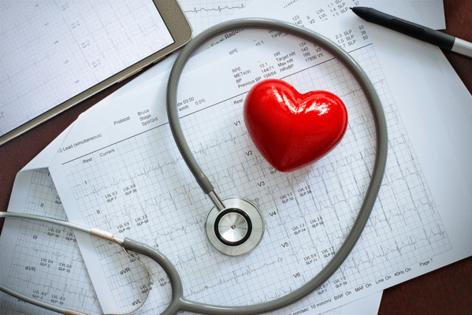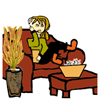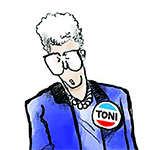Family, faith and therapy helped her recover from cardiac arrest, triple bypass and stroke
Published in Mom's Advice
Staying fit was important to Linda Griffin, especially after she was diagnosed with high blood pressure. That came after the birth of her third child, April, when Linda was 29. Since then, she'd taken medication to control her blood pressure.
She was also concerned about heart disease because her father had two bypass surgeries. He later died from a heart attack when he was 62. After that, she started regularly getting cardiology checkups.
In Linda's daily life, she worked a stressful job as a dependency investigator with the Department of Children and Family Services of Los Angeles County. Linda enjoyed working with families and helping them reunite with their children.
Linda also loved going to the gym. After she retired from social work at 61, she was a regular at the gym. She also really enjoyed walking around the park near her home in Inglewood, California, a suburb of Los Angeles.
Just as Linda had been in the service of others in her career, she continued doing so in retirement, such as volunteering to help people recovering from addiction to regain custody of their children and counseling members at the church she has belonged to since 1979.
Then the COVID-19 pandemic hit and Linda, like most people, was forced to stop most of her activities. When her world slowly opened back up in early 2021, she of course felt happier. However, she found herself feeling inexplicably tired.
That March, at her regular cardiology appointment, a stress test showed some abnormalities. At 67, the doctor suggested she undergo a cardiac catheterization procedure that would allow a closer look at her heart.
Linda preferred to first see if she could improve her heart health through exercising and the homeopathic medication she'd started taking.
A few weeks later, Linda was grocery shopping when she suddenly felt dizzy and weak. She rushed home and told her husband, Charles, that she needed to go to the hospital.
Doctors discovered several blocked coronary arteries. She needed a triple bypass to restore normal blood flow through her heart.
While doctors were examining her, Linda's heart stopped. It took three shocks from a defibrillator to restore a rhythm. The bypass surgery had to be delayed a few days.
Linda's triple bypass surgery was a success, but days later, while in recovery, she had a stroke.
Doctors were able to remove the clot that caused the stroke. But when Linda woke up, she at first didn't recognize her husband, children or any of her relatives. She also couldn't talk or move her arms and legs.
Within days, Linda's speech returned. So did some movement. But her ability to swallow remained compromised enough that she had to be fed through a tube.
Physical therapy progressed slowly. Part of the problem was the pain Linda felt from the bypass surgery and other procedures. The workouts left her exhausted all the time. Plus, lingering ramifications of the stroke left her mind feeling somewhat incoherent.
Friends, family and church members, including the pastor and his wife, visited Linda in the hospital, which lifted her spirits.
"All of the love is what started to bring me back," Linda said.
For a couple weeks, she improved.
Then came several setbacks. An infection, which led to a buildup of fluid in her lungs. Her kidney function became so poor that she needed dialysis. She became depressed.
After nearly a month in the hospital, doctors and therapists feared the cumulative toll may have done too much damage to Linda, physically and emotionally. They asked Charles and April to consider bringing in hospice care.
"Absolutely not," April said.
Soon after, a nurse discovered that Linda was low on hemoglobin, a protein in the blood that carries oxygen. Linda received a blood transfusion.
As her hemoglobin level returned to normal, so did Linda.
"It was like night and day," April said. "I could see it in her face almost immediately."
Linda eventually began physical therapy at a rehabilitation facility. As she showed improvement, Charles and April – who had remained in California to care for her mother – thought she might thrive even more if she returned to more familiar surroundings. So, Linda returned to Inglewood.
While at home, Linda received palliative care, which is physical, emotional and spiritual support for people living with chronic conditions or serious illness. (Although it's often associated with terminally ill patients, that's not always the case.)
"My hope level changed dramatically being home," Linda said.
A team of caregivers helped Charles and April set up the guest room to mimic the room in the facility.
When she settled in, Linda could use her upper body and could stand, but not walk. She spent her days in bed or in a wheelchair. She still needed dialysis and a feeding tube.
Linda received therapy for cognition, movement and strength several days a week. On days therapists didn't visit, April worked with her.
Within two months at home, Linda could swallow and no longer needed dialysis.
At the five-month mark, Linda was able to walk.
"I have to believe that staying in shape before really helped me for later," she said.
April eventually felt her mother's recovery was complete enough that she could return to her home in Dallas.
"A year later, my family told me I did not look like what I had been through," Linda said. "It was a true blessing from God."
Now, three years after her bypass and stroke, Linda has had to deal with some medical problems, including an ongoing thyroid issue. She's lost some weight and strength and there are a few other lingering effects of her ordeal.
She sometimes gets depressed and anxious but tries to manage it by reaching out to specialists; she also sees a therapist weekly. Linda tells herself to remember "everything I went through was for a reason." She also relies on her faith, believing "that God brought me through it all." Strength and comfort also come from Charles, her husband of 49 years, and her three children.
She feels most like her old self when she can walk around the park near her house. She's eager to regain as much of a new life and lifestyle as possible.
"I want to do more things that bring me back into balance," she said. "Community service, travel, exercise – all those things give me purpose in life."
____
Stories From the Heart chronicles the inspiring journeys of heart disease and stroke survivors, caregivers and advocates.
American Heart Association News covers heart and brain health. Not all views expressed in this story reflect the official position of the American Heart Association. Copyright is owned or held by the American Heart Association, Inc., and all rights are reserved.










Comments